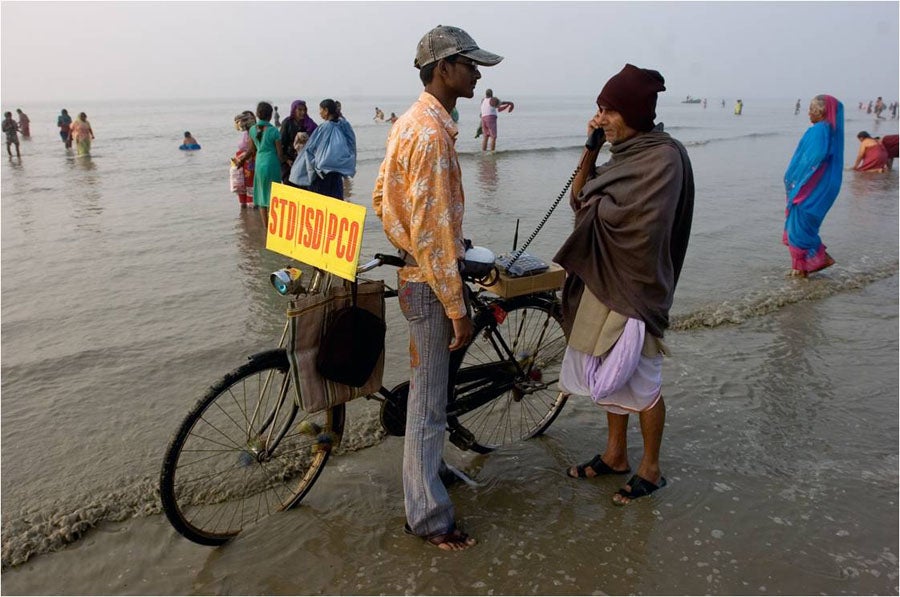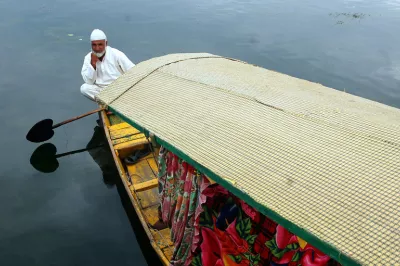The Future of Provider Ecosystems for Financial Inclusion
After extensive external and internal consultations, the CGAP Board (ExCom) approved the next five-year strategic direction for CGAP at its annual meeting in Amsterdam. The strategic direction lays out five priority themes, desired outcomes, and activities against each priority. We're highlighting these themes in a special blog series. The second post of the series below describes CGAP's approach to build provider ecosystems to advance financial inclusion.
We have yet to crack the challenge of delivering a range of financial services to poor people at scale and low cost. One thing is clear -- no one type of provider is likely to overcome this challenge alone. An ecosystem involving multiple providers where each provider plays a specialized role will ultimately close the inclusion gap. The question is how do we get to that future ecosystem?
The good news is that the future where multiple providers serve the poor is closer than many of us realize. In Pakistan, for example, the list of providers that reach the poor includes 43 microcredit providers, as well as four mobile network operators, four large banks doing agent banking, agent companies, the national switch, and new finance and technology companies. There is a broad policy environment behind those providers that includes different regulators and public sector entities. From Mexico to Ghana to Indonesia, a similar environment is starting to take shape.
 A man makes a phone call from a bicycle while standing in the ocean.
A man makes a phone call from a bicycle while standing in the ocean.
Photo Credit: Sudipto Das
CGAP’s five-year strategy recognizes that in most countries poor people are more likely to get financial services from a range of commercial and public sector actors. The CGAP strategy aims to address the unprecedented challenges and opportunities for financial inclusion this complex ecosystem presents.
Agent and mobile banking contributed to this changing ecosystem. “When we bought Tameer Microfinance Bank [in Pakistan] we expanded the banking footprint overnight. That’s the disruptive power of MNOs,” said Abraham Foss, head of financial services for Telenor on a panel discussion on provider ecosystems at last week’s CGAP annual meeting. In the past five years, the global branchless banking space has grown significantly with 190 businesses, 32 of which are reaching over 1 million and 13 reaching over 5 million customers each. “So MNOs are different and have different DNA. If we are serious about financial inclusion, it is really about leveraging the MNO networks,” said Nick Hughes, who developed M-PESA and now helps run M-KOPA in Kenya.
Despite growth in widespread agent networks and many more poor people transacting via mobile phones, the progress across markets is not uniform. There are questions about how to unlock scale especially where interconnection in more competitive markets for mobile money could help, an area of emphasis in CGAP’s strategy. It is also unclear what role banks will play with many more failed partnerships between banks and mobile network operators than successful ones. “For many years, the view was that inclusive banking was not a viable business,” said Daphne Motsepe, who used to head South Africa’s ABSA Bank’s business in inclusive banking and was on the panel with Foss and Hughes. “This view was based on past attempts that had failed. However, with agent-driven banking models, banks are encouraged to a play a role in inclusive banking. Pretty much every bank in South Africa now has a strategy for financial inclusion.”
“It is clearly not about replicating the old banking models,” summarized IFC’s Peer Stein who moderated the panel with Motsepe, Foss, and Hughes. New models are needed as providers strike partnerships to bring a range of financial products beyond the basic remittance and bill payment services that are now prevalent across implementations. As part of the strategy, CGAP will work with providers to identify low-cost technology-enabled business models.
It is hard to predict which providers and institutions will belong to the ecosystem of the future. “[We’re] not sure if we can really be institution agnostic when it comes to innovation,” said a senior member of CGAP’s board. In a live poll at the meeting last week, one of the members picked retailers as playing a bigger role with innovating for financial inclusion as they appeared to her to be the most unlikely actor today: “Ten years ago nobody would have voted for MNOs, so I voted for retailers because they might be the ones for the future.” Omidyar Network’s Arjuna D’costa reminded us that “the actor that comes up with the innovation may not be the one that takes it to scale.”
The strategy also identifies work with providers to source insights from consumers using approaches like “human-centered design,” which CGAP has been experimenting with recently. “In ten years the institutions that will have made a big difference for financial inclusion is not one type of institution but actually any actor that is good at translating customer insights into a value proposition that is relevant,” remarked CGAP CEO Tilman Ehrbeck. Moreover, data on clients, especially the footprints left from cell phone use, are increasingly figuring in products designed for poor consumers. While gaining momentum, product development with this data is quite nascent, and there is lot to be understood on both business and policy perspectives.
We have also started to see the emergence of new businesses that are using digital finance to bring real services to people in energy, water, health, agriculture, and other areas. CGAP’s strategy will explore this new space – there are already over 60 businesses trying to develop solutions across various sectors. Last week, Hughes described M-KOPA, an energy business where people pay small amounts via M-PESA to lease or own SIM-operated solar lanterns (watch video describing the solution). “The ability to move a small amount of money around is a powerful enabler,” commented Hughes. The business is starting to take off and provides a window into what the future provider ecosystem in financial inclusion could look like.
With its new strategy, CGAP intends to contribute to the emergence of this ecosystem across multiple markets. So what will this future ecosystem look like? Today, a poor family in Ghana can get basic credit, pay bills, and get basic life insurance from multiple providers - MFIs, banks, and mobile network operators. In the future, if a robust provider ecosystem emerges, that family will be able to save with more flexibility, get safer and smarter credit, and use finance to get access to water and clean energy, all enabling them to lead a higher quality of life.
------ The authors are part of the technology and business model innovation team at CGAP.




Comments
Regarding the CGAP’s
Regarding the CGAP’s strategic direction for the next five year and proposed activities for bringing desired outcome I would like to share a few comments on the priority themes and causal claim (desired outcome and activities) and make some
suggestions from the perspectives of the excluded bottom pyramid in poverty rich continents
First, clarity in selecting target group and forecasting ‘desired outcome’ for the theme arena should be more demand oriented and transparent. In the context of persistent exclusion phenomenon sometime even after inclusion also , despite innovations in financial sector, it is prudential to conceive positive outcome for the poorest in the bottom pyramid in terms of sustainable inclusion and their graduation. The fact is highlighted because inclusion drive need to go down in all the layers in the pyramid and should not cease at surface of the pyramid and claim success by using the term like ‘The poor” or small farmer or SMEs or low income people .To quote an example, in the case of agricultural sector, one need to target first vulnerable group consisting of the marginal farmers, agricultural land less laborers, small tenant farmers or oral lease farmers, bonded laborers etc instead of claiming for small farmers (current CGAP priority), Here if small farmers are focused with priority , the others, who are more vulnerable group in the farm sector as mentioned above are likely to get excluded. Further, so long they are also constituents of poverty . poverty also cannot be reduced if they remain excluded. Here the point is for whose desire the outcome to emerge ? and for whose desire the outcome has to satisfy ? Are they in the demand side or supply side ?
Second, as a corollary to the above, in the causal claim chain, the ‘desired outcome’ is linked to activities and unless appropriate activities are strategically planned or designed tailored to the needs of the excluded both before and after inclusion desired outcome is impossible. Further, the desired outcome could not be realized with mere inclusion or provision of products irrespective of mode unless eco system is developed for supporting both the activities related to the inclusion and after inclusion equally for impacting desired outcome.
Third, better understanding the causal relationship among the theme, desired outcome and the activities is a pre requisite. In the case of small farmers category, there is diversity in their pattern of holding in terms of size, quality (wet or dry land) pattern of crop cultivation, commercial crops/food crops, inputs requirements, marketing etc. All these production linked input activities and happen after inclusion for which who takes the responsibility in terms of Client protection and empowerment being the key focus of Maya declaration for financial inclusion?. Can the actors in the supply chain like mobile company, net work service provider, correspondent banker, take the client protection (newly included) for the pre and post inclusion activities ? , On similar vein, what are the activities for the inclusion of excluded group in agricultural sector as referred to above.
Fourth too much of assumption in the post inclusion stage has led to sordid situation
with unintended consequences like gap between rich and poor as Kenyan felt and exclusion of included in SHG system as Indian experienced. Therefore eco system for responsible inclusion demand not necessarily multiple actors & digitalized modes in supply side albeit useful but importantly multiple activities related to outcome in the post inclusion stage .
Last, financial inclusion will not deliver desired outcome without adequate eco system in terms of physical infrastructure (like roads, culvert, power, communications etc) in the economically backward regions where most of the excluded are present.
Dr Rengarajan
Add new comment